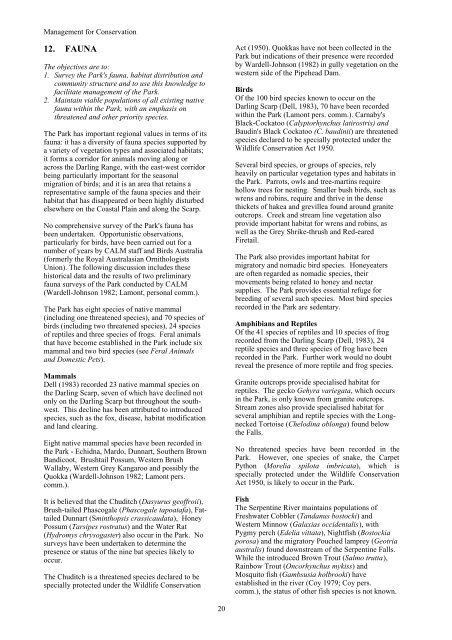Serpentine National Park - Department of Environment and ...
Serpentine National Park - Department of Environment and ...
Serpentine National Park - Department of Environment and ...
You also want an ePaper? Increase the reach of your titles
YUMPU automatically turns print PDFs into web optimized ePapers that Google loves.
Management for Conservation<br />
12. FAUNA<br />
The objectives are to:<br />
1. Survey the <strong>Park</strong>'s fauna, habitat distribution <strong>and</strong><br />
community structure <strong>and</strong> to use this knowledge to<br />
facilitate management <strong>of</strong> the <strong>Park</strong>.<br />
2. Maintain viable populations <strong>of</strong> all existing native<br />
fauna within the <strong>Park</strong>, with an emphasis on<br />
threatened <strong>and</strong> other priority species.<br />
The <strong>Park</strong> has important regional values in terms <strong>of</strong> its<br />
fauna: it has a diversity <strong>of</strong> fauna species supported by<br />
a variety <strong>of</strong> vegetation types <strong>and</strong> associated habitats;<br />
it forms a corridor for animals moving along or<br />
across the Darling Range, with the east-west corridor<br />
being particularly important for the seasonal<br />
migration <strong>of</strong> birds; <strong>and</strong> it is an area that retains a<br />
representative sample <strong>of</strong> the fauna species <strong>and</strong> their<br />
habitat that has disappeared or been highly disturbed<br />
elsewhere on the Coastal Plain <strong>and</strong> along the Scarp.<br />
No comprehensive survey <strong>of</strong> the <strong>Park</strong>'s fauna has<br />
been undertaken. Opportunistic observations,<br />
particularly for birds, have been carried out for a<br />
number <strong>of</strong> years by CALM staff <strong>and</strong> Birds Australia<br />
(formerly the Royal Australasian Ornithologists<br />
Union). The following discussion includes these<br />
historical data <strong>and</strong> the results <strong>of</strong> two preliminary<br />
fauna surveys <strong>of</strong> the <strong>Park</strong> conducted by CALM<br />
(Wardell-Johnson 1982; Lamont, personal comm.).<br />
The <strong>Park</strong> has eight species <strong>of</strong> native mammal<br />
(including one threatened species), <strong>and</strong> 70 species <strong>of</strong><br />
birds (including two threatened species), 24 species<br />
<strong>of</strong> reptiles <strong>and</strong> three species <strong>of</strong> frogs. Feral animals<br />
that have become established in the <strong>Park</strong> include six<br />
mammal <strong>and</strong> two bird species (see Feral Animals<br />
<strong>and</strong> Domestic Pets).<br />
Mammals<br />
Dell (1983) recorded 23 native mammal species on<br />
the Darling Scarp, seven <strong>of</strong> which have declined not<br />
only on the Darling Scarp but throughout the southwest.<br />
This decline has been attributed to introduced<br />
species, such as the fox, disease, habitat modification<br />
<strong>and</strong> l<strong>and</strong> clearing.<br />
Eight native mammal species have been recorded in<br />
the <strong>Park</strong> - Echidna, Mardo, Dunnart, Southern Brown<br />
B<strong>and</strong>icoot, Brushtail Possum, Western Brush<br />
Wallaby, Western Grey Kangaroo <strong>and</strong> possibly the<br />
Quokka (Wardell-Johnson 1982; Lamont pers.<br />
comm.).<br />
It is believed that the Chuditch (Dasyurus ge<strong>of</strong>froii),<br />
Brush-tailed Phascogale (Phascogale tapoatafa), Fattailed<br />
Dunnart (Sminthopsis crassicaudata), Honey<br />
Possum (Tarsipes rostratus) <strong>and</strong> the Water Rat<br />
(Hydromys chrysogaster) also occur in the <strong>Park</strong>. No<br />
surveys have been undertaken to determine the<br />
presence or status <strong>of</strong> the nine bat species likely to<br />
occur.<br />
The Chuditch is a threatened species declared to be<br />
specially protected under the Wildlife Conservation<br />
20<br />
Act (1950). Quokkas have not been collected in the<br />
<strong>Park</strong> but indications <strong>of</strong> their presence were recorded<br />
by Wardell-Johnson (1982) in gully vegetation on the<br />
western side <strong>of</strong> the Pipehead Dam.<br />
Birds<br />
Of the 100 bird species known to occur on the<br />
Darling Scarp (Dell, 1983), 70 have been recorded<br />
within the <strong>Park</strong> (Lamont pers. comm.). Carnaby's<br />
Black-Cockatoo (Calyptorhynchus latirostris) <strong>and</strong><br />
Baudin's Black Cockatoo (C. baudinii) are threatened<br />
species declared to be specially protected under the<br />
Wildlife Conservation Act 1950.<br />
Several bird species, or groups <strong>of</strong> species, rely<br />
heavily on particular vegetation types <strong>and</strong> habitats in<br />
the <strong>Park</strong>. Parrots, owls <strong>and</strong> tree-martins require<br />
hollow trees for nesting. Smaller bush birds, such as<br />
wrens <strong>and</strong> robins, require <strong>and</strong> thrive in the dense<br />
thickets <strong>of</strong> hakea <strong>and</strong> grevillea found around granite<br />
outcrops. Creek <strong>and</strong> stream line vegetation also<br />
provide important habitat for wrens <strong>and</strong> robins, as<br />
well as the Grey Shrike-thrush <strong>and</strong> Red-eared<br />
Firetail.<br />
The <strong>Park</strong> also provides important habitat for<br />
migratory <strong>and</strong> nomadic bird species. Honeyeaters<br />
are <strong>of</strong>ten regarded as nomadic species, their<br />
movements being related to honey <strong>and</strong> nectar<br />
supplies. The <strong>Park</strong> provides essential refuge for<br />
breeding <strong>of</strong> several such species. Most bird species<br />
recorded in the <strong>Park</strong> are sedentary.<br />
Amphibians <strong>and</strong> Reptiles<br />
Of the 41 species <strong>of</strong> reptiles <strong>and</strong> 10 species <strong>of</strong> frog<br />
recorded from the Darling Scarp (Dell, 1983), 24<br />
reptile species <strong>and</strong> three species <strong>of</strong> frog have been<br />
recorded in the <strong>Park</strong>. Further work would no doubt<br />
reveal the presence <strong>of</strong> more reptile <strong>and</strong> frog species.<br />
Granite outcrops provide specialised habitat for<br />
reptiles. The gecko Gehyra variegata, which occurs<br />
in the <strong>Park</strong>, is only known from granite outcrops.<br />
Stream zones also provide specialised habitat for<br />
several amphibian <strong>and</strong> reptile species with the Longnecked<br />
Tortoise (Chelodina oblonga) found below<br />
the Falls.<br />
No threatened species have been recorded in the<br />
<strong>Park</strong>. However, one species <strong>of</strong> snake, the Carpet<br />
Python (Morelia spilota imbricata), which is<br />
specially protected under the Wildlife Conservation<br />
Act 1950, is likely to occur in the <strong>Park</strong>.<br />
Fish<br />
The <strong>Serpentine</strong> River maintains populations <strong>of</strong><br />
Freshwater Cobbler (T<strong>and</strong>anus bostocki) <strong>and</strong><br />
Western Minnow (Galaxias occidentalis), with<br />
Pygmy perch (Edelia vittata), Nightfish (Bostockia<br />
porosa) <strong>and</strong> the migratory Pouched lamprey (Geotria<br />
australis) found downstream <strong>of</strong> the <strong>Serpentine</strong> Falls.<br />
While the introduced Brown Trout (Salmo trutta),<br />
Rainbow Trout (Oncorhynchus mykiss) <strong>and</strong><br />
Mosquito fish (Gambsusia holbrooki) have<br />
established in the river (Coy 1979; Coy pers.<br />
comm.), the status <strong>of</strong> other fish species is not known.

















